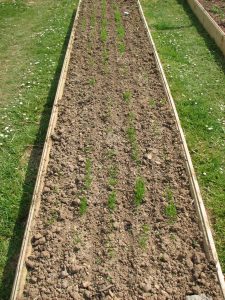Carrots can be grown as early or maincrop varieties. But you’ll also find carrots come either in short rooted or long rooted varieties.
They main difference between short rooted and long rooted varieties is that one or the other is more suitable to certain types of soil. Short rooted varieties will grow in any type of soil because they root doesn’t go very deep. While the long rooted variety needs much better soil structure to get the long roots.
Carrots (and any other deep rooted vegetable) like to grow in a light and sandy soil. If you have light soil you can grow either short or long rooted type of carrots But, if your soil is heavier with some clay and is stony, or maybe is just doesn’t drain very well, then you are better off to grow just short rooted maincrop variety as these are better able to cope with these types of soil condition.
Growing Carrots – Site and Soil
To grow a good crop of carrots it really very much depends on the quality of your garden soil. So it’s well worth taking the time to prepare your vegetable patch. Carrots like to grow in full sun, but they will also grow in partial shade.
Dig the soil over either in late winter or early spring, you need to remove any stones that you find whilst digging, thoroughly dig the soil over until it starts to resemble a fine texture. At this time you can also dig in some sand to make the soil lighter.
Two weeks before sowing you can prepare the seedbed, at this time you can also rake in some bonemeal or rake in a light covering of general fertiliser. Rake the carrots seed bed until it has a lovely crumbly texture to the soil.
Tip: If your soil in the garden isn’t good enough to grow a root vegetable like carrots then you can grow them in a container, pots or in a raised bed.
Growing Carrots – When To Sow Carrots
If you sow carrots over several succession sowings then you can ensure that you can eat carrots from as early as June to October (even longer if you store them).
You can sow carrots as early as February but you will need to sow the seeds under cloches. July is the last month that you can sow your carrot seeds.
So from February to July you can sow every 2 to 3 weeks to have a continuous fresh supply of carrots.
How To Sow Carrots
 Sow the seeds as thinly as possible on a dry sunny day. Using a hoe, make a shallow drill around 2-3cm deep and around 15cm apart. Carrot seed is very fine, and the best way I have found to sow the seeds is to put some of the carrot seeds in your palm of your hand and take a pinch of seeds with your other hand and sow very thinly along the drill.
Sow the seeds as thinly as possible on a dry sunny day. Using a hoe, make a shallow drill around 2-3cm deep and around 15cm apart. Carrot seed is very fine, and the best way I have found to sow the seeds is to put some of the carrot seeds in your palm of your hand and take a pinch of seeds with your other hand and sow very thinly along the drill.
Tip: If you find it difficult sowing the carrots thinly, you can try mixing the carrot seeds with some sharp sand and then sow the seeds and sand together. This will allow you to sow the carrots more thinly and the sand will help aid with drainage.
Once the seeds are sown cover the carrots seeds with some very fine soil. Water the drills with a watering can that has a fine spray. The carrot seedlings should start to appear 14 to 21 days later depending on the weather.
Tip: In your garden centre you can also buy carrot seed tapes or pelleted carrot seed, this makes the sowing much easier because all you do is lay the tape in your seed drill and cover. The downside is that they are more expensive to buy.
How Long from Sowing to Harvesting Time
Early carrot varieties take 10-12 weeks, and the maincrop can take around 16 weeks. Maincrop carrots take up space in your garden, but they do tend to last longer and store better.
How To Grow Carrots – Looking After Your Carrot Crop
Water the carrots if the weather is very dry, and try and keep them as weed free as possible.
Once the carrot seeds have germinated and their first leaves as shown, then this is a good time to thin the seedlings to 3-5cm between each plant. This allows you to grow bigger carrots.
Tip: When thinning out the carrot seedlings this will release the scent of carrots, and this can attract the carrot fly. It’s better to thin the carrot seedlings in the evening when there is less chance of the carrot fly being about. Also you need to ensure that any soil that is disturbed by the thinning is pushed back down again with your hand – as the carrot fly lays their eggs in loose soil that is around the carrot seedlings.
Harvesting Your Carrots
Early carrots are best picked when they are young and tender. But for maincrop carrots you are better off to let the foliage begin to wilt and die back, this means that the carrots have reached maturity.
Use a garden fork to get the carrots up, push the fork in gently next to the carrot row and push the fork forward and backward to loosen the carrots grip on the soil. The carrots can now be pulled up by hand.
Growing Carrots – Pests & Diseases
Carrot fly – The main threat to carrots is the carrot fly. The carrot fly is attracted to the carrots by the smell of the foliage when it’s crushed. You can reduce an attack by thinning the carrots in the evening on a still day; you also need to remove the thinnings and watering them afterwards. Carrot fly is a low-flying insect: so you can also erect a ‘wind-break’ style guard around the carrot crop as this can help deter them.
Green Top
Sometimes you find that your carrot has green at the top of the root when you are harvesting them. Unlike potatoes – green carrots are not harmful to eat. Green top is caused by sunlight when it shines on the top of the exposed carrot crowns. You can prevent this by making sure the top of the carrot crowns are covered up with soil.
Fork Roots – Forked roots also known as fanging is caused by adding manure or compost to the soil before you sow the seeds. It can also be caused by stony soil or by heavy soil that hasn’t been dug properly.
Splitting – Splitting is caused by too much rain or over-watering after a dry spell. The split roots won’t store so eat them immediately. In very dry times water the carrots regularly, also you can add mulch such as compost or grass clippings around the carrots to stop them from drying out to much.









